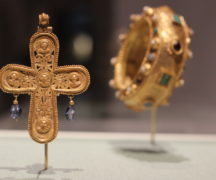From TOLEDO MUSEUM OF ART
Brian P. Kennedy, Ph.D., the Edward Drummond and Florence Scott Libbey Director of the Toledo Museum of Art (TMA) has been named the Rose-Marie and Ejik van Otterloo Executive Director and CEO of the Peabody Essex Museum (PEM) located in Salem, Massachusetts. He will take up his new post at PEM in July of this year.
Founded in 1799, PEM is one of the nation’s oldest—as well as fastest growing—museums in the country. Focused on innovation and impact, PEM is dedicated to creating experiences of art, culture and creative expression that transform people’s lives by broadening their perspectives, attitudes, and knowledge of themselves and the wider world.
TMA was founded in 1901 and Kennedy served as the ninth director. His last day at TMA will be June 30, 2019.
“It has been an honor to serve as director of the Toledo Museum of Art,” Kennedy said. “I am deeply grateful to the Museum staff, our members, the TMA board and the local community for entrusting me to lead this institution, the gem of Toledo, for nearly nine years and to contribute to its rich history.”
Kennedy began his role as director, president and CEO of the Toledo Museum of Art in September 2010 with extensive experience in senior leadership positions at art museums in Ireland, Australia and the United States. A strategic thinker and collaborative leader, he is a respected art historian, curator and author. Kennedy studied art history and history at University College in Dublin, earning bachelor’s, master’s and doctoral degrees.
“Brian is a visionary museum director who has had a significant impact on TMA’s visitors, its collection, the campus and the surrounding community,” said Cynthia B. Thompson, chair of the Museum’s board. “His legacy will be felt in Toledo for generations to come.”
As a thought leader in visual literacy and sensory learning, Kennedy expanded the Museum’s purpose of art education by launching a visual literacy initiative, in which the TMA collection is used to teach people of all ages and backgrounds to read, comprehend and write visual language. The curriculum developed as part of this initiative, The Art of Seeing Art™, formed the foundation for TMA’s teacher professional development workshops, staff training and the Center of Visual Expertise (COVE), its business consultancy in safety and hazard recognition, among other programs.
TMA made significant art acquisitions over Kennedy’s tenure as director, among them works by Frans Hals, Luca Giordano, Juan Martínez Montañés, Charles-François Daubigny, Alfred Stieglitz, Bill Viola, Naim June Paik, Frank Stella, Sean Scully, Agnes Martin, Jaume Plensa, Magdalene Odundo, Ravinder Reddy, Romuald Hasoumé, El Anatsui, Mary Sibande, Alice Neel, Takashi Ishida and Monir Farmanfarmian. The collection strategy of TMA also broadened to incorporate a more global focus, while also collecting for the first time works of indigenous arts of Native America, Aboriginal Australia and Oceania.
Under Kennedy’s guidance a diverse exhibitions program was organized, which included five categories of projects: exhibitions with international partners such as Manet: Portraying Life with the Royal Academy, London, The Art of the Louvre’s Tuileries Gardens with two U.S. museums and the Louvre and Frans Hals Portraits: A Family Reunion, currently at the Royal Museums of Fine Arts of Belgium, Brussels; exhibitions on themes local (The Battle of Lake Erie and The American Civil War: Through Artists’ Eyes) and international (Fresh Impressions: Early Modern Japanese Prints); shows focused on the exceptional work of individual artists (Frank Stella: Irregular Polygons and Revelation: Major Paintings by Jules Olitski); exhibitions of indigenous art (Crossing Cultures and Indigenous Beauty: Masterworks of American Indian Art from the Diker Collection); and a series of multisensory, immersive installations such as Anything Can Break by Pineree Sanpitak, Play Time and Rebecca Louise Law: Community, among others.
TMA also hosted the Glass Art Society conference in 2012 and celebrated 50 years of studio glass with the major glass exhibition Color Ignited along with hosting the International Visual Literacy Association in 2014.
During Kennedy’s time as director, the Museum continued its record for annual visitation when measured as a percentage of Toledo’s metropolitan area population. TMA has averaged over 400,000 visits per year from 2015 to 2018, while the population of the Toledo metropolitan area was 651,429 in 2017.
In addition to increasing attendance, the Museum’s outdoor campus and the square footage of its gallery space expanded considerably. The TMA grounds now cover nearly 40 acres in Toledo’s Old West End neighborhood. In 2012 the Museum refurbished 6,000 square feet of gallery space, and 14,000 square feet of new and refurbished gallery space in the Museum’s west wing opened to the public in 2018 in the largest renovation project to take place at TMA since the 1980s.
Other highlights from Kennedy’s career as director include establishing the TMA 2020 Vision strategic plan, raising $46 million for the Polishing the Gem endowment campaign and delivering a comprehensive Master Plan for the institution, its buildings and surrounding campus that will be carried out over the next 20 years.
“The Museum is entering an exciting chapter in its history,” stated Thompson. “And due to Brian’s dynamic approach to developing Museum staff, collaborative leadership and success as a fundraiser, TMA is strongly positioned to realize the vision set forth in the Master Plan.”
In the coming months, the TMA board of directors will name an interim director and begin the search process for the Museum’s next inspiring leader.





